|
|
Lhasa Attractions |
|
Tourist Attractions in Lhasa |
|
Barkhor Street
The Barkhor Street is the oldest street of old Lhasa
city. This street is situated in the heart of Lhasa and
circle the Jokhang Temple. It is the trading as well as
religious center of the city. The word Barkhor means a
pilgrim's inner circuit. It dates back to the foundation
of the Jokhang Temple and is an essential pilgrimage
route. This path was used by the Buddhist pilgrims as a
walk around path for Jokhang temple. But now, this is
the most bustling shopping place in entire Tibet. The
Barkhor Street is also known as 'the window of Tibet' as
it typically reflects the Tibetan life and culture. The
|
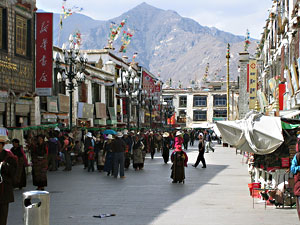 |
|
|
street is
dotted with ancient houses which also serve as shops.
Religious objects such as prayer flags, prayer wheels,
thangkas (a kind of mounted scroll paintings), sutras, prayer
beads, etc. as well as jewellery, Silver ornaments, Tibetan
knives, costumes, yak wool and different kinds of handicrafts
are easily available in this ancient street. But the specialty
of this street is definitely the eateries that are the famous
and delicious dishes of Tibetan cuisine. The street also has
other facilities like inns, restaurants, cafes, etc. that
serve locals as well as tourists. Do not forget to pay a visit
to the apparel stores as they too have the uniqueness and
special Tibetan look in their products. This street combines
ancient, modern, religious and everyday life in perfect
harmony and is a must-see for all visitors!
|
|
|
|
Jokhang Temple
The Jokhang Temple is one of the most sacred and
important temple in Tibet. The tourists and pilgrims
visit this temple in large numbers, throughout the year.
In the past, the temple complex was expanded and it now
covers an area of about 25,000 square meters. It was
always an important pilgrim destination for Tibetans,
but after being added in the list of World heritage site
by UNESCO, "Historic Ensemble of the Potala Palace", the
temple is now a major attraction for all the tourists
visiting the town. This temple is a spiritual center of
|
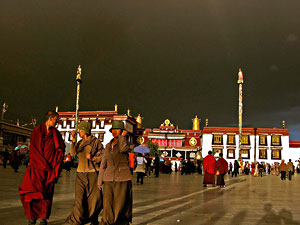 |
|
|
Lhasa, it is perhaps the most popular tourist attraction in
Lhasa. Jokhang Temple was built by King Songtsan Gampo
probably in 642 and located in heart of the Lhasa city in
Tibet. It was originally called the Rasa Tulnang Tsuklakang or
'the House of Mysteries', the Magical Emanation at Rasa. The
temple is permeated with purity. The Jokhang temple is rightly
erected in the center of the ground which was earlier a lake.
The lake was chosen as the site after many attempts failed to
build a temple in the region. Every time a structure was
erected, it would collapse on its own. Everybody was surprised
by this unusual turn of events. Princess Bhirkuti then
approached Princess Wen Cheng who was more knowledgeable than
others. She pointed out that the topography of the city was
not very conducive to construction due to the presence of
lake. She advised that the lake should be filled and leveled
up. You will be amazed to know that more than 1000 sheep's
were used to bring soil from a mountain quite a distance away.
And after the temple was build, it came to be known as Ra-Sa-
Vphrul Snang. In Tibetan language, 'Ra' means sheep and 'Sa'
means earth. The city around also was called Ra-Sa, which is
now known as Lhasa. The temple houses the famous life size
statue of Sakyamuni which is considered to be most sacred for
Tibetans, and was brought to Tibet by the Bhrituti and
Wencheng, the Nepalese and Chinese wives of King Songtsen
Gampo as wedding gifts. The famous Buddhist Master, Atisha,
taught here in the 11th century and it has been considered the
most important temple in Lhasa ever since. This temple has
remained a key center of Buddhist pilgrimage for centuries. It
was sacked several times by the Mongols, but the building
survived. Originally it was constructed on the bases of Indian
vihara design, and was later extended resulting in a blend of
Nepalese and Tang Dynasty styles. The Jokhang temple is a
four-storey building, with roofs covered with gilded bronze
tiles. The main hall of the complex is around 1300 years old
housing the statue of Sakyamuni, which probably is the most
venerated statue in entire Tibet. In the hall, there is a
'Dharma Wheel' confined between two deer on either side of the
wheel. The Jokhang temple complex has several decorated
shrines and rooms. It also houses famous statues of Chenresig,
Padmasambhava and King Songtsan Gambo and his two famous
foreign brides, Princess Wen Cheng of China and Princess
Bhrikuti of Nepal. Many of the statues were destroyed during
the "Cultural Revolution" but have been remade very often by
the broken pieces of the original statues. If you want to see
the whole Jokhang complex in a single view, climb on to the
square of the Jokhang temple, from where you will get the most
amazing scenes of the temple. Here you will find two big
slabs, both inscribed. One stands as testimony to the alliance
between kings of Tibet and Tang and the other has the method
of preventing the cureless smallpox disease. The temple is
open to general public from 9 AM in the morning till 8 PM in
the evening. At least 4 hours are needed to explore this
wonderful monument. |
|
|
|
Norbulingka Palace
Norbulingka Palace, situated in the west side of Lhasa,
is just around a km southwest of Potala Palace.
Norbulingka literally means "the Jewelled Park" or the
“Treasure Park”. It is a garden full of palaces, build
by different Dalai Lamas and which served as the
traditional summer residence of the successive Dalai
Lamas from 1780 till the PRC takeover in the late 1950.
It was first built in the forties of the eighteenth
century, covering a space of 40 hectares after
continuous expansion by the Dalai Lamas. Now, the garden
covers an |
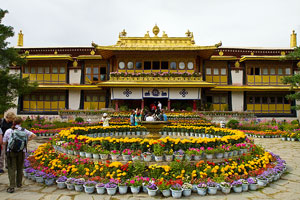 |
|
|
area of
around 46 acres and has 370 lavishly furnished rooms. It is
considered to be the biggest man made garden in Tibet. It is
called summer palace because after the 7th Lama, Dalai Lamas
used to visit here during summers to hold religious and
government related activities. In 2001, UNESCO inscribed
Norbulingka on its World Heritage List as part of the
"Historic Ensemble of the Potala Palace". The area on which
the palace stands today used to be a wasteland full of weeds
and wild animals. The 7th Dalai Lama often visited the place
and spend his time here. Seeing this the Qing magistrate
ordered for a palace to be built in the garden. The
construction of the palace was started in 1740 and named as
the Norbulingka garden. In 1751, the 7th Dalai Lama himself
started the construction of his own palace called Kelsang
Potrang inside Norbulingka itself. This is a 3 floor building
which has bedrooms, reading rooms, worship halls and
sanctuary. In its life span of more than 200 years,
Norbulingka has seen a lot of construction on it. The 8th
Dalai Lama built a lake and a group of buildings called C. The
8th Dalai Lama named Tyoksil Potrang built the palace which is
known for its architectural splendor. The earliest building is
the Gesang Pozhang Palace built by Kelzang Gyatso. Khamsum
Zilnon is another eye-catching building behind the main gate.
It was originally a Han style pavilion and later changed into
a theater where the Dalai Lamas watched Tibetan opera. Tsokyil
Potrang is a group of buildings on water. Dalai Lamas used to
read in a hall of the palace. Construction seldom stopped
under the reigns of different Dalai Lamas. In 1922, the 13th
Dalai Lama began to build his Golden Lingka and Chensel
Potrang, which is located at the back of the woods. The palace
was heavily painted with murals, which bear strong Han
characteristics. In 1956, the 14th Dalai Lama finished his own
palace - Takten Migyur Potrang, usually called New Summer
Palace. Though it is called New Summer Palace, it is a very
traditional architecture except for its interior modern
facilities. In the palace there are many splendid murals
painted by a 14th Dalai Lama's painter. The topics of the
murals include Tibetan officials, Sakyamuni preaching under a
Bodhi tree, and Tibetan history from its founding by the Holy
Monkey, the vicissitudes of Tubo Kingdom (633-844) and Tibetan
Buddhism to Panchen Lama and Dalai Lama's interviews with
Chairman Mao Zedong in Beijing. Norbulingka palace holds
beautiful gardens that are favorite picnic spots and provide a
beautiful venue for theatre, dancing and festivals,
particularly the Sho Dun or 'Yoghurt Festival'. It is
celebrated at the beginning of August, with families camping
in the grounds for days surrounded by colourful makeshift
windbreaks of rugs and scarves and enjoying the height of
summer weather. There is also a zoo at Norbulingka, originally
to keep the animals which were given to the Dalai Lama.
Heinrich Harrer helped the 14th Dalai Lama build a small movie
theatre there in the 1950s. This is the best picnic spot quite
popular among locals. The garden is open from 9 AM in the
morning till 12 noon and again reopens at 3 PM in the evening
and closes just an hour after at 4 in the evening.
|
|
|
|
Yamdrok Tso Lake
Yamdrok Tso or Yamdrok Yumtso Lake is a holy lake
located about 100 km to the south-west of the capital
city of Tibet, Lhasa. In Tibetan language the word
Yamdrok means upper pasture and Tso refers to lake, thus
literally Yamdrok Tso means Upper Pasture Lake. This
beautiful turquoise blue lake is situated at an altitude
of 4,441 meters above sea level. It is the largest
freshwater lake at the south foot of the Himalayas with
an area of about 678 square kilometers. The lake has a
length of 130 kilometers and a width of 70 kilometers.
It is quite a deep lake with the average |
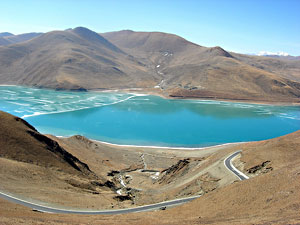 |
|
|
depth of
about 20-40 meters and the deepest point is almost 60 meters
below the surface. It is the third largest lake on the Tibetan
Plateau and one of the most holy lakes in Tibet. It has no
outlet and no permanent source of incoming water, however the
snow melted from the surrounding mountains occasionally feed
the lake. This lake has some interesting names that have been
coined from its unique features. For example, the name Coral
Lake is derived from its irregular shape. It has many short
streams snaking into the nearby mountains and provides it a
coral like appearance. It is also called Green Jade Lake
because the pure clean water of the lake looks as smooth as
the surface of fine jade. When overlooked from the nearby high
mountain, the Lake appears like a holy sapphire, set in the
group of mountains. The reflection of sunshine in different
depths of lake gives it attractive and mysterious colors.
Situated amidst snow-capped mountains and dotted with several
small islands with their fertile grasses and groups of wild
birds, Yamdrok Tso Lake offers a heavenly magnificence and
tranquility. According to the Tibetan believes, Yamdrok Yumtso
Lake is the female Guardian of Buddhism in Tibet. Tibetan
people believe that it will bless and protect them. It is one
of the popular pilgrimages in Tibet and every year, large
number of devotional followers in Tibet or from other places
would come here for pilgrimage. Some devotees start on foot
and give one prostration every three steps even from hundreds
of kilometers away. It shows their respect and devotion for
this charming holy lake. |
|
|
|
Potala Palace
Potala Palace is located in the heart of Lhasa city.
Potala Palace has become a landmark for the city. Potala
Palace is located on the side of Marpo Ri hill, the Red
Mountain at an altitude of 3,700 m. The Potala Palace
was named after Mount Potala, the abode of Chenresig or
Avalokitesvara. The first palace was built by King
Songtsen Gampo in 637 in order to |
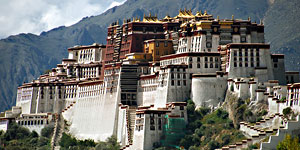 |
|
|
greet his bride Princess Wen
Cheng of the Tang Dynasty of China.
More... |
|
|
|